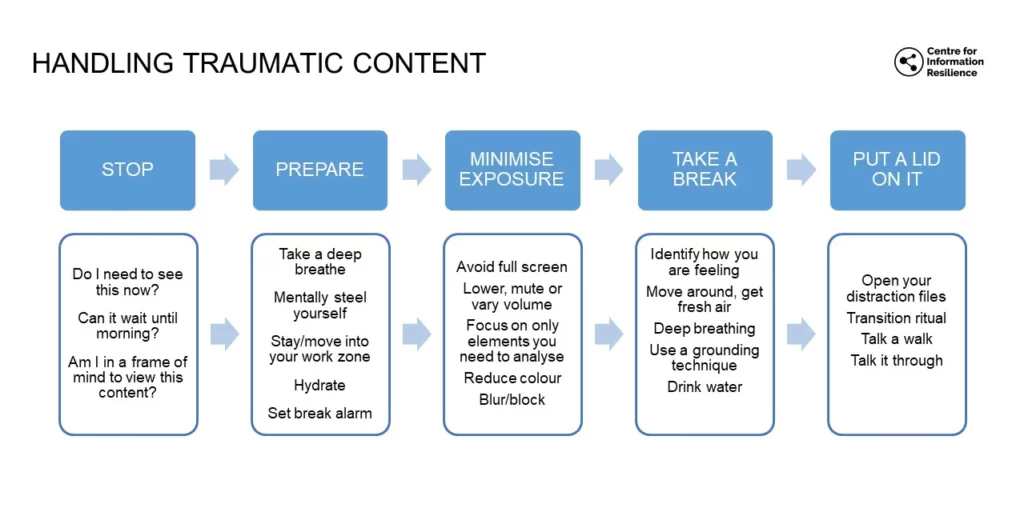CIR Pioneer Approach to Protect Team Well-Being in the Midst of Traumatic Content Exposure
This Thursday, November 16, the Center for Information Resilience (CIR), one of the seven members of our working group at ObSINT, unveiled its visionary protocol for minimising the mental health impacts of traumatic exposure on its staff and partners.
By Sophie CheckFirst, 16 November 2023

This internal material aligns completely with our core-value “A diverse, safe and caring work environment” (ObSINT Guideline chapter 5), showing CIR efforts to protect their staff well-being and the safety of people involved in research and dissemination. CIR is an independent non profit, renowned for its commitment to exposing human rights abuses and war crimes, countering disinformation and combating online behaviour harmful to women and minorities. By releasing these in-depth details of their approach, they aim to help others implement such internal policies.
A body lying in a street. A small shoe in the ruins of a bombed-out school. A hate-filled rant inciting violence. Open-source investigators seek to help bring accountability for these acts. In doing so, they expose themselves to the risks of vicarious trauma – an emotional response to the witnessing of traumatic events.
Vicarious trauma takes many forms. It might manifest as intrusive thoughts of suffering while lying in bed, feelings of hopelessness or guilt at the misery of others, a sense of dislocation from colleagues and family, or a sick feeling in the stomach. It can be triggered by work on a particular event or build up over time as the result of repeated exposure to traumatic images. An increasing number of organisations and individuals involved in open-source research have been telling their stories, and sharing tips and resources, to help normalise discussions around mental health and support researchers build resilience (the excellent work of Bellingcat, the University of Berkeley’s Human Rights Centre, the Dart Centre and others). CIR contributes to that conversation with the publication of their internal guidelines on working with traumatic content.
The guidelines set out protocols and tools to help minimise exposure to traumatic content and its impact. It provides guidance on the warning signs of vicarious trauma, as well as details of support available. Vicarious trauma affects people in different ways. Their focus is on supporting individuals to recognise their own risk factors and triggers and find coping strategies that work for them alongside organisational protocols that mitigate risk across the organisation.

Specialist support is not enough, often the first line of response is the team itself
They have compiled some of the lessons they have learned along the way:
- Prevention is better than cure. “We’re trying to get more proactive in managing exposure to traumatic content, integrating trauma risk assessment into investigation planning, taking trauma into account when setting taskings and workloads, building in mental health breaks and tracking the mental and emotional load our investigators take on.”
- It’s not just about traumatic imagery. “It’s the combination of stressors from personal life, work pressures, negative news cycles and emotionally challenging investigations”. As a result, they offer an assistance program for all employees and consultants which provides not just 24/7 counselling and specialised mental health support, but also a legal, financial and debt helpline, relationship counselling and, care and special educational needs advice.
- While specialist support is available, often the first line of response sits with the team members. CIR team offers team leaders and managers trainings on how to hold conversations around mental health; lead debriefs on potentially traumatic events and identify and refer those who might benefit to specialist support.
- Building trauma awareness into project workflows and systems can help take the load of individuals to manage their own self-care. CIR includes a “red, amber, green” graphic content warning embedded in their datasets, a tagging system that warns people of the type of content they might encounter before they look at it, disabling auto-previews from all collaboration platforms and setting up virtual escape rooms filled with cute animals.
The CIR internal guidelines embody ObSINT’s commitment to prioritizing the mental health of staff exposed to distressing content during investigations. We encourage all organizations, media outlets, and members of civil society to follow their steps.
Download CIR’s internal policy on handling traumatic content